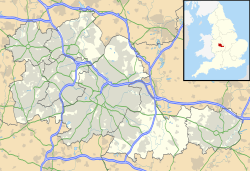All Saints' Church, Small Heath (II) facts for kids
Quick facts for kids All Saints’ Church, Small Heath |
|
|---|---|

All Saints’ Church, Small Heath (formerly St Aidan’s)
|
|
| 52°28′13.84″N 1°51′59.69″W / 52.4705111°N 1.8665806°W | |
| Location | Small Heath, Birmingham |
| Country | England |
| Denomination | Church of England |
| Churchmanship | Anglo-Catholicism |
| Website | allsaintsonline.co.uk |
| History | |
| Former name(s) | St Aidan’s Church, Small Heath |
| Dedication | All Saints |
| Consecrated | 14 October 1896 |
| Architecture | |
| Heritage designation | Grade II* listed |
| Architect(s) | Thomas Frederick Proud |
| Groundbreaking | 2 September 1893 |
| Completed | 1898 |
| Specifications | |
| Bells | 1 |
| Administration | |
| Parish | All Saints Small Heath |
| Deanery | Yardley and Bordesley |
| Archdeaconry | Aston |
| Diocese | Anglican Diocese of Birmingham |
| Province | Province of Canterbury |
All Saints' Church in Small Heath, Birmingham, is a special old church. It's part of the Church of England. Before 1998, it was known as St Aidan's Church. This church is so important that it's listed as a Grade II* building, which means it has a lot of historical value.
History of the Church
This beautiful church was designed by a talented architect named Thomas Frederick Proud.
Building the Church
The very first stone of the church was put in place on September 2, 1893. This important moment was led by Lady Mary Wood. A year later, on September 2, 1894, the first part of the church was ready and opened its doors.
The church was officially made a holy place, or consecrated, on October 14, 1896. This ceremony was performed by the Bishop of Worcester. At that time, it was known as St Aidan's Church. The font, which is a special basin used for baptisms, came from St Stephen's Church, Bristol. In 1897, a new church area, called a parish, was created around St Aidan's.
Changes and New Name
In the 1990s, some big changes happened in Small Heath. Four churches in the area – St Aidan's, St Gregory's, St Andrew's, and St Oswald's – joined together. The people in the new combined parish decided to keep only the St Aidan's building. In 1998, this church was given a new name: All Saints' Church. It took this name from an older church that used to be in the area.
The Church Organ
In 1999, an organ built in 1871 by a company called Taylor of Leicester was brought to All Saints' Church. You could find details about this organ on the National Pipe Organ Register.
However, the organ was moved from the church in 2012. It was taken to Holy Trinity Church in Sutton, Somerset. The part of the organ that made it work, called the blower, was not moved with it. Instead, it was given to the Leicester Museum service. They wanted to keep it because it was a great example of Taylor's work.


